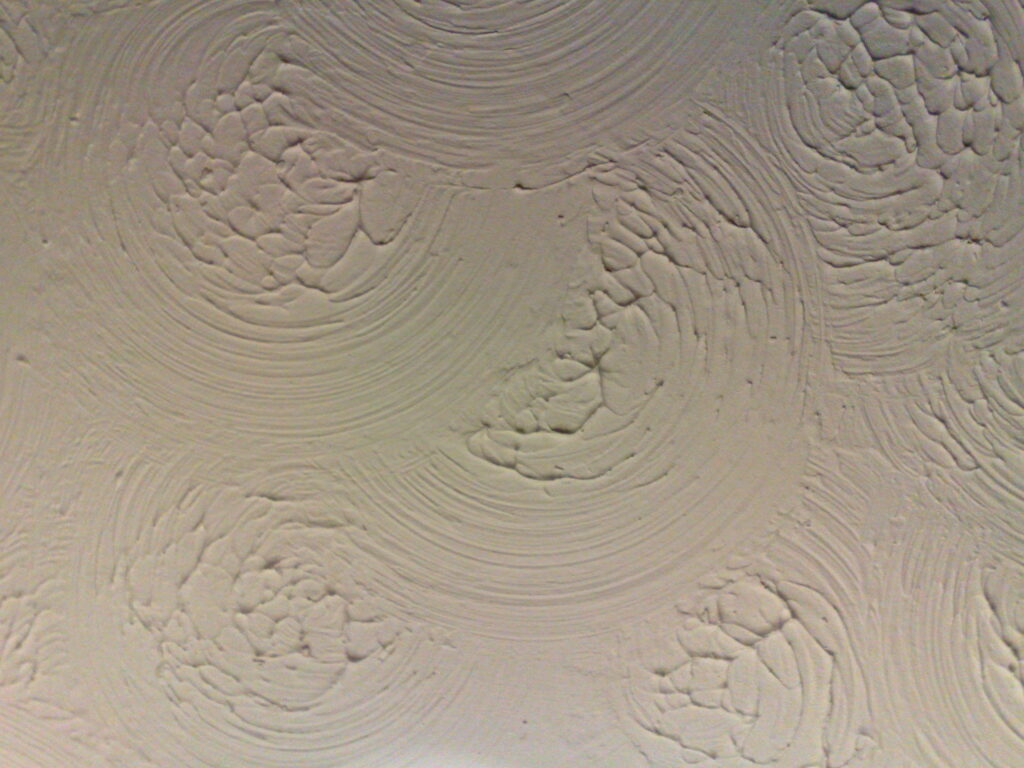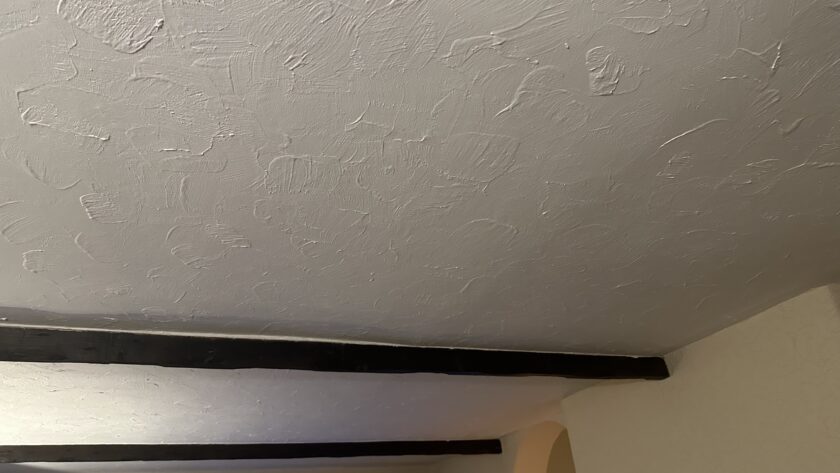So, we’ve recently moved into our new fixer-upper house, and while we absolutely love it, there’s one thing that’s been bothering us: the artex ceiling in the lounge. It’s not exactly what we had in mind for our dream living space, but we also didn’t want to break the bank or risk safety concerns by attempting a full-scale removal. That’s when we started exploring alternative options for dealing with our artex ceiling conundrum. If you’re in a similar situation and looking for practical solutions, you’re in the right place. In this post, I’ll dive into everything you need to know about artex ceilings, from understanding what they are to exploring safe and cost-effective methods for dealing with them. Let’s turn that textured ceiling into a feature you can be proud of!
What is Artex?

To begin with, lets take a look at what the hell it is. Artex is a textured coating applied to ceilings and walls to create decorative patterns or designs. It gained popularity in the mid-20th century as a way to add visual interest and hide imperfections in surfaces. Artex ceilings often feature intricate swirls, stippling, or geometric patterns, giving rooms a unique and textured appearance.
Despite its decline in popularity in recent years, many homeowners still appreciate artex for its ability to add character and depth to a space. Its textured surface can help disguise uneven or damaged ceilings, making it a convenient option for renovation projects. Additionally, artex was once lauded for its acoustic properties, as the texture helped to absorb sound and reduce echo in rooms. For some, the nostalgic charm of artex also holds sentimental value, reminding them of a bygone era of interior design. Whether it’s for practical reasons or simply personal preference, artex ceilings continue to find their place in homes across the country. However, we are a young family and whilst we are trying to retain some of the older aspects of our home as part of the refurb, we knew that the artex ceiling had to go.
Is Artex Safe?
Artex, particularly older formulations, may pose health risks due to the potential presence of asbestos. Asbestos was commonly used in construction materials, including some artex products, until its ban due to health concerns in the late 20th century. If your home was built before the mid-1980s, there’s a possibility that the artex contains asbestos fibers, which can be hazardous when disturbed. Now, whilst the asbestos content of your ceiling will likely be extremely low, it is best to try and avoid exposure over a long term where possible.
Modern artex formulations, however, are asbestos-free and comply with strict safety regulations. Manufacturers have adapted their products to meet contemporary safety standards, ensuring that they pose minimal health risks to homeowners.
To determine whether your artex contains asbestos, it’s advisable to have it professionally tested. Asbestos testing involves collecting samples of the material and analyzing them in a certified laboratory. If asbestos is present, precautions must be taken to avoid exposure during removal or renovation.
When considering DIY removal of older artex, safety should be the top priority. It’s essential to take appropriate precautions to minimise the risk of asbestos exposure. This includes wearing personal protective equipment such as gloves, goggles, and a respirator to prevent inhalation of asbestos fibers. Additionally, it’s crucial to follow safe removal practices, such as wetting the material to minimise dust and using proper disposal methods for asbestos-containing waste.
Methods of Removal of Artex Ceiling
When it comes to removing artex, there are several methods to consider, each with its pros and cons. Here are some popular options:
1. Scraping:
Scraping involves physically removing the artex texture using a scraper or putty knife. While this method can be effective, it can also be labor-intensive and messy, as it may create dust and debris.
2. Steaming:
Steaming involves softening the artex texture with steam before scraping it away. This method if defintely easier than scraping alone, and can make the removal process easier and less messy. However, it may still require significant effort, especially for larger areas.
3. Skim Coating an Artex Ceiling:
Skim coating is a technique where a thin layer of plaster or joint compound is applied over the artex surface to create a smooth finish. This method can effectively cover the texture of the artex, but it requires skill and patience to achieve a flawless result.
4. Overboarding an Artex Ceiling:

Overboarding involves covering the existing artex ceiling with a new layer of plasterboard, creating a smooth surface for painting or wallpapering. This method is less disruptive than removing the artex altogether and can be a cost-effective solution, especially if the artex is in good condition.
5. Refreshed Coat of Paint:
Sometimes, simply painting over the artex with a fresh coat of paint can be enough to update its appearance. While this method doesn’t remove the texture, it can help to camouflage it and give the ceiling a refreshed look.
In our case, we’ve opted for a combination of overboarding and skim coating as the most budget-friendly option. While skimming alone might seem like a cheaper alternative, there’s a risk that the skim coat may struggle to bond properly with the artex surface, leading to potential issues down the line. By overboarding first and then applying a skim coat, we can ensure a smoother finish and a more durable result. This solution cost us around £500 for our lounge, measuring 4.8m x 4.3m. We also have wooden beams in our lounge which our plasterer very nicely plastered up to, which has left them looking really nice and integral to the look of our new ceiling.
In Conclusion
In conclusion, artex ceilings have been a popular choice for many homeowners over the years, offering a textured finish that adds character to a room. However, concerns about safety and aesthetics have led some to seek alternatives or removal options.
Throughout this post, we’ve explored what artex is, why people use it, safety considerations, and methods of removal. Whether you choose to keep your artex ceiling or opt for removal, it’s essential to weigh the pros and cons carefully.
For those considering removal, there are various methods available, from scraping and steaming to skim coating and overboarding. Each method has its advantages and challenges, so it’s essential to assess your ceiling’s condition and your budget before making a decision.
In our case, we decided to have our artex ceiling overboarded and skimmed, providing a smooth and modern finish without the need for complete removal. This approach offered a cost-effective solution while ensuring a durable and visually pleasing result.
Ultimately, the choice to treat or remove artex ceilings is a personal one, depending on individual preferences and circumstances. Whatever path you choose, we encourage you to assess your ceiling’s condition and explore the available options to achieve the desired look and feel in your home.





